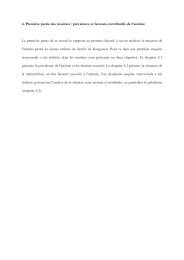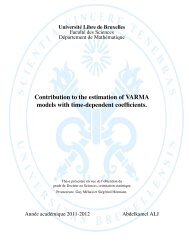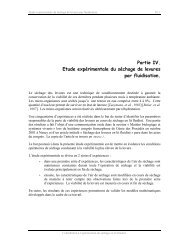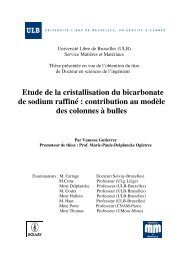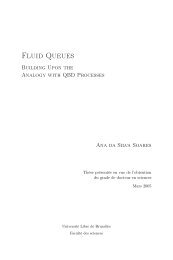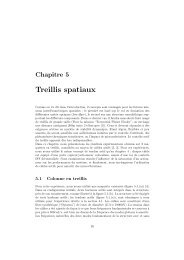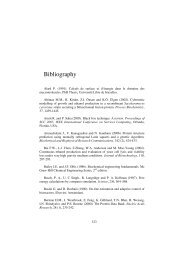Diapositive 1 - de l'Université libre de Bruxelles
Diapositive 1 - de l'Université libre de Bruxelles
Diapositive 1 - de l'Université libre de Bruxelles
You also want an ePaper? Increase the reach of your titles
YUMPU automatically turns print PDFs into web optimized ePapers that Google loves.
Chapitre Vmagnesium concentration. Kwak et al (2005) highlighted the importance of thecrystallization pathway in impurity entrapment into calcite (Kwak et al 2005).Mineralization through an ACC transient phase is suggested to be an essential step in theformation of high magnesium calcites (Raz et al 2000, Loste et al 2003, Cheng et al 2007)and has been showed to be favoured in magnesium-rich solutions (Kwak et al 2005). TheACC has been suggested to be stabilized by high concentration of magnesium in thesolution (Raz et al 2000, Loste et al 2003). Moreover, the stabilization of ACC has been<strong>de</strong>monstrated to be also partially completed by the organic matrix (Raz et al 2000, 2003).Once formed, this amorphous phase favours the incorporation of elevated quantities ofmagnesium, and these high concentrations are conserved in the crystal after crystallisationand co-occurring water expulsion (Loste et al 2003). Raz et al (2000) suggested that theincorporation of high magnesium levels results from a combined effect of an elevatedMg/Ca ratio in the precipitation compartment and the involvement of an organic matrixinducing the formation and stabilization of an ACC. Our observations suggest a possiblelink between the relative abundance of aspartic acid rich proteins in the organic matrixand the magnesium incorporation, which probably proceed through ACC stabilization bythe Asp-rich proteins.In conclusion, we showed that solution Mg/Ca ratio is the main factor affectingmagnesium incorporation in in vitro precipitated calcium carbonate <strong>de</strong>posits. Organicmatrix macromolecules induced an enhancement of magnesium incorporation in themineral. This effect has been shown to be specific and more pronounced for SOMextracted from a magnesium-richer skeletal element. We suggest that the origin of thisenhancement arises from the combined effects of high Mg/Ca ratio in solution andpresence of organic matrix, both inducing and stabilizing a magnesium-rich amorphousphase. The involvement of the organic matrix in this process can explain the observationthat sympatric organisms or even different skeletal elements of the same individualpresent different magnesium concentration in the mineralized skeleton.AcknowledgementsThe authors wish to thanks C. De Bruyn for its SCUBA diving assistance, S. M’zoudi fortechnical support, Ph. Compère for providing the protein extraction <strong>de</strong>vice, and N.Dakhani for the specimen analysis. This work was supported by a “Plan Action 2” grant(contract n r WI/36/F02), a “David and Alice Van Buuren” grant, the CALMARS II107



